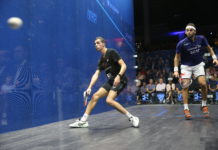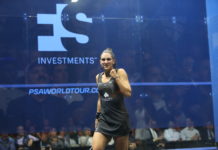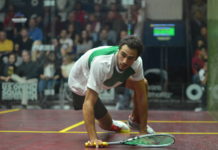By Lynn Leong, U.S. Junior Women’s Assistant National Coach
In March, I wrote about the boast. While it is one of my favorite shots, the lob is another under-appreciated tool in a squash player’s arsenal. The lob can be used to slow the game down when you find yourself under pressure because it gives you time to regain your position at the T. But the beauty of the lob is that it can be both an attacking and defensive shot because hitting the ball high and wide can create loose returns from your opponent while you recover to an attacking position.
Used well, in combination with a drop shot, the lob and drop is a ver y effective attacking strategy. Because I was not a hard- hitting player, the lob and drop worked well for me as a competitive player as it was an excellent way to counter players who preferred to hit the ball hard.
The angle of the lob has to be just right—high, wide and soft enough that when it hits the side wall it dies in the back corner. Many players hit the lob either too high and wide, so that it goes out of court, or too hard so that it just comes right back into the court making an easy return for their opponent—while you’re still recovering to a strong position.
While tough to perfect, the key to the lob is in the technique and knowing how to use the height and angle. So book a lesson with your teaching pro to get the most out of this article, because most players do not use the lob unless they have been taught or exposed to this beautiful and highly effective shot.
3.0
Most club players think squash must be played as if they are in a high-speed chase, so learning to slow the game down can be difficult. However, watching some of the best players in the world who use the lob effectively can be very helpful (players like Rachael Grinham and James Willstrop come to mind), and lessons with a pro are important for the technique and placement. One drill for the 3.0 player to begin developing the lob is the “boast and lob” where one player boasts the ball to the front and the other plays a cross-cour t lob in return. Focus on using little to no back swing, keeping the racquet beneath the ball and lifting the ball up on the front wall. The objective is to hit the ball near the top line (within a couple feet) to create an arc that will carry the ball deep into the back corners over the head of your opponent.
4.0
At the 4.0 level, players will have star ted becoming comfortable with the objective of the lob. However, at this level it’s important to star t developing the ability to play the lob while approaching the corners from different angles and under more pressure. With this in mind, a drill at this level would be “boast, lob, volley drive.” In this scenario, the key is to focus on getting height on the lob to give you time to recover and be able to play the next boast after the volley drive. If your lob is too low or played with too much pace, your playing partner will be able to play the ball very early and bury the ball in the back corner. So keep in mind not only your target high on the front wall but also the pace. The lob serve is also something 4.0 players can start developing.
5.0
Adding even more pressure, 5.0 players can begin working on their boast and lob together. The “boast, drop, lob, volley drive” will require you to use pace that will give you ample time to cover opposite corners and still hit the boast and lob effectively. Playing a lob in response to the drop is a classic combination in squash and will enable you to force your opponent back and for th to opposite corners. At this level, the lob should be played to bury your opponent in the back corner to force a weak defensive shot. If played extremely well, your opponent will have a very difficult time playing a drive off your lob and will instead play a weak defensive boast—providing you with an easy drop shot opportunity.






